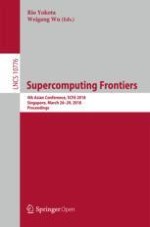1 Introduction
-
We design and implement a versatile framework to meet the necessity of performance optimization and power management for power-constrained large scale HPC systems.
-
By showing three case studies, we demonstrate how this framework works and how it is used to carry out certain power management tasks under different power control strategies.
-
We also prove the effectiveness of this framework through these three case studies.
2 Related Work
2.1 Power-Performance Optimization
2.2 Interfaces to Control Power-Knobs
2.3 Performance Profiling and Analysis Tools
2.4 Domain Specific Language to Describe System Performance and Configuration
2.5 Towards a Versatile Power Management Framework
3 The Proposed Power Management Framework
3.1 Overview and Power Management Workflow Control
-
Analyzing source code and applying automatic instrumentation
-
Measuring and controlling application power consumption and performance
-
Optimizing an application under given power budget
-
Specifying and defining the target machine specification
-
Calibrating hardware power consumption of the system
3.2 Application Instrumentation for Profiling and Optimization
3.3 Power Control and Application Optimization
3.4 Machine Specification and Setting
3.5 Hardware Calibration
4 DSL to Control Power Management Workflow
4.1 Semantics of the DSL
CREATE/DELETE | Creating or deleting an object |
ADD/REMOVE | Adding or removing an attribute for an object |
GET/SET | Setting or getting the value of an attribute |
LIST | Listing objects |
INSERT | Manual instrumentation to application source |
SWITCH | Switching between user/admin or switching to a different machine |
SUBMIT | Submitting jobs to the system |
4.2 Implementation of the DSL Interpreter
Number of nodes | 16 |
|---|---|
Processor | Intel Xeon E5-2680 |
Number of sockets per node | 2 |
Number of cores per socket | 8 |
Memory size per node | 128 GB |
Interconnect | Infiniband FDR |
OS | Red Hat Linux Enterprise with kernel 2.6.32 |
Compiler | FUJITSU Software Technical Computing Suite |
MPI | Open MPI 1.6.3 |
Applications | EP and IS (Class D) from the NPB Suite |
